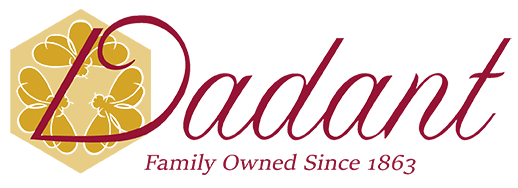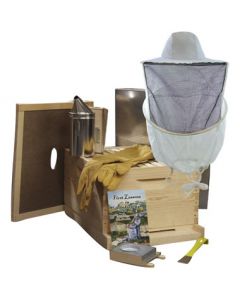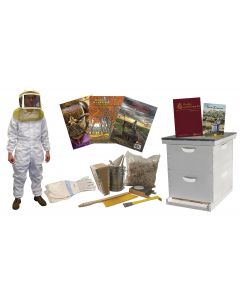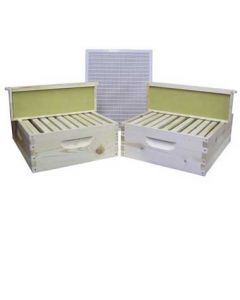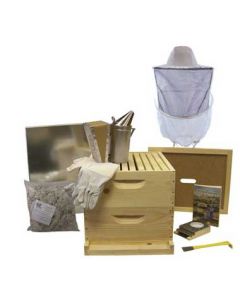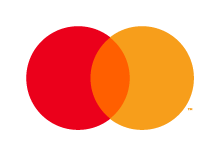Hive Kits (10-Frame)
Basic Parts of a Beehive
Most beekeepers in the U.S. and Canada buy 10-frame beehive kits for their honey bees, but 8-frame hives have become more popular in the past few decades. 10-frame hives give bees two additional frames for honey and brood production.
In comparison, 8-frame beehives are lighter when full, which make them easier to handle if standard hives are too heavy. These hives also fit in smaller spaces, which is convenient for small backyards.
Knowing the parts of a beehive is vital for understanding your colony. A basic hive consists of seven components: A hive stand, bottom board, hive body, queen excluder, honey super, inner cover and a hive cover.
Parts of a Beehive
Hive Stand: A hive stand elevates the hive off the ground. This keeps the bottom board dry and helps insulate the hive. Our 10-Frame Hive Stand Select Unassembled protects the hive bottom and gives bees an angled landing area.
Bottom Board: A bottom board is the floor of a beehive. This includes a single entrance for bees to enter and exit the hive as well as help them defend the hive from possible threats. The entrance has two settings: a wide setting for warmer months and a reduced size for colder conditions. Our 10-Frame Bottom Board Commercial Unassembled allows 3/4" for a summer entrance and 3/8" for winter. Some beekeepers will buy screened bottom boards as an alternative because they provide more ventilation, which makes the beehive cooler in summer and improves moisture levels in winter.
Hive Body: A hive body, also known as the brood chamber, brood nest, brood box or deep super, sits on top of the bottom board and serves as the living quarters for the colony. 10-frame hive bodies are 9 ½” in height and can weigh up to 85 pounds when filled with honey, brood or pollen. Some beekeepers purchase 8-frame hives because they are about 10 pounds lighter than 10-frame hives when filled. Our 8-Frame Deep Beginner’s Kit Unassembled is perfect for beginner hobbyists.
Queen Excluder: The queen excluder is a flat section of the hive with a gauged metal grid. The precise size of the grid prevents the larger queen and drones from leaving the hive body, but allow the smaller worker bees to pass through. This restricts the queen to laying eggs and raising brood in the hive body, while the workers fill frames in the upper section with honey. If the queen lays eggs in the honey super, it can be more difficult to extract clean honey from the hive. Our 10-frame metal bound queen excluder is perfect for standard hives.
Honey Supers: Honey supers are located above the hive body. They function as a storage place for honey and pollen for months when honey flow and pollen collection are not possible. Bees will eat their way up the hive body to the super and consume stockpiled honey and pollen for survival. This is where beekeepers will “pull” honey. When full, a 10-frame super will yield more honey, brood and pollen compared to an 8-frame super. Dadant offers painted and assembled supers as well as unassembled supers for honey supers, such as the 10-Frame Medium Super 6 5/8" Commercial Unassembled, which is widely used among commercial beekeepers.
Inner Cover: Beekeepers use inner covers to increase circulation of fresh air, increase circulation, and allow moisture to escape the beehive. Dadant offers a variety of inner covers, including some see-through inner covers made of laminated glass and perfect for taking a quick look at your hive.
Outer Cover: Also known as the outer cover, the beehive cover is a critical component used to provide additional protection, ventilation and insulation for the honey bees. Some outer covers have a telescoping shape, which keeps the hive dry and bees safe from the elements. Dadant offers a variety of outer cover designs, including the 10-Frame Polystyrene Telescoping Outer Cover, which is weather-resistant as well as cooler in summer and warmer in winter.
Choosing a hive doesn’t have to be daunting. Our unassembled hive kits are perfect for beginner beekeepers who enjoy DIY projects. Building a hive helps beekeepers gain an intimate knowledge and familiarity of the beehive’s structure. Simply follow the building instructions, place it in a backyard, and add honey bees. Honey bee colonies are not included in either assembled or unassembled kits.
